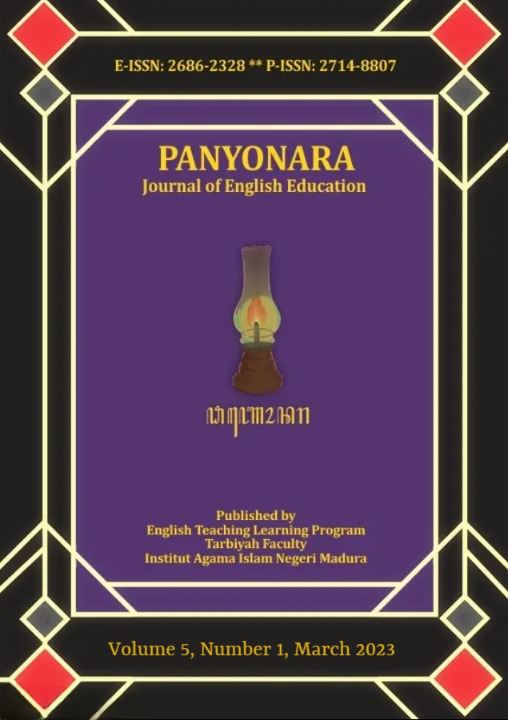Study about Student’s Perception toward the Use of Smart TV in Learning Speaking on the Material Giving and Asking of Instructions
 Abstract views: 478
,
Abstract views: 478
,
 PDF downloads: 809
PDF downloads: 809
Abstract
To improve students' ability to speak passively especially in teaching asking and giving instructions material, supporting devices are needed since students need media or teaching strategies that are relevant. The purpose of this study was to discuss more deeply in the context of students’ perception about the use of Smart TV on the learning process in the classroom which is also related to the problems experienced by students and also to the output produced by students. The design of the study was descriptive qualitative. The subjects of the study were 19 students from 34 students in MTsN Gresik at 8 th grade. The data was collected through a questionnaire, interview and the student’s own performance. The study revealed that students responded to Smart TV as a media in learning speaking on the material asking for and giving instructions are positive:
they strongly agreed that by using Smart TV, the learning process more lively, fun and meaningful.
Downloads
References
Ahmadi, M. R. (2017). The Impact of Motivation on Reading Comprehension. International
Journal of Research in English Education, 2(1), 1–7. doi:
18869/acadpub.ijree.2.1.1
Arriyani, N., & Pratama, P. (2021). English Virtual Based Learning: Integrating Technology
And Learning Media Through ‘Assure’ Teaching Mode. 10(2), 421–429.
Dunleavy, M., Dexter, S., & Heinecke, W. F. (2007). What Added Value does a 1:1 Student to
Laptop Ratio Bring to Technology-Supported Teaching and Learning?: Original
Article. Journal of Computer Assisted Learning, 23(5), 440–452. doi: 10.1111/j.1365-
2007.00227.x
Edumadze, J., Kuadey, N. A., & Mensah, S. E. (2019). Students’ Perception of Mobile Learning
at University of Cape Coast, Ghana. The Online Journal of Distance Education and E-
Learning, 7(3), 226–235.
Healey, M., Jordan, F., Pell, B., & Short, C. (2010). The Research-Teaching Nexus: A Case Study
of Students’ Awareness, Experiences and Perceptions of Research. Innovations in
Education and Teaching International, 47(2), 235–246. doi:
1080/14703291003718968
Juslin, P. N., & Laukka, P. (2004). Expression, Perception, and Induction of Musical Emotions:
A Review and a Questionnaire Study of Everyday Listening. Journal of New Music
Research, 33(3), 217–238. doi: 10.1080/0929821042000317813
Leithner, A. (2009). Review of Blended Learning: Using Technology in and Beyond the
Language Classroom. Language, Learning and Technology, 13(1), 33–39.
Lestari, sri R. S. (2012). Students’ Perceptions of the Use of Internet in Writing Vi Course in
English Language Education Study Program of Sanata Dharma University.
Progressio, 34(1), 113–126.
Octaberlina, L. R. (2022). Interlanguage Analysis of Indonesian Young Learner’s English
Acquisition. 4(2), 175–189.
Prayudi, R. A., Hakiki, A. K., Putra, N. R. D., Anzka, T. O., & Ihsan, M. T. (2021). The Use of
Technology in English Teaching & Learning Process. Jurnal Riset Dan Inovasi
Pembelajaran, 1(2), 102–111. doi: 10.51574/jrip.v1i2.38
Reviews, B. (2002). Music and Emotion: Theory and Research. Choice Reviews Online,
(01), 40-0198-40–0198. doi: 10.5860/choice.40-0198
Safitri, M. (2021). Students’ Perception of the Use of Social Media for Learning English: A Case
Study at the Eleventh-Grade Students of SMA Al-Hasra in Academic. 93.
Yudapratama, A. F., & Madiun, U. P. (2022). Analisis Minat Belajar Siswa Menggunakan Media
Smart TV di SDIT Permata Ummat. 3, 505–514.
The journal uses an Open Access policy under a Creative Commons Attribution-NonCommercial 4.0 International License. Authors who publish with this journal agree to the following terms:
- Authors retain copyright and grant the journal right of first publication with the work simultaneously licensed under a Creative Commons Attribution License that allows others to share the work with an acknowledgment of the work's authorship and initial publication in this journal.
- Authors are able to enter into separate, additional contractual arrangements for the non-exclusive distribution of the journal's published version of the work (e.g., post it to an institutional repository or publish it in a book), with an acknowledgment of its initial publication in this journal.
- Authors are permitted and encouraged to post their work online (e.g., in institutional repositories or on their website) prior to and during the submission process, as it can lead to productive exchanges, as well as earlier and greater citation of published work.
















